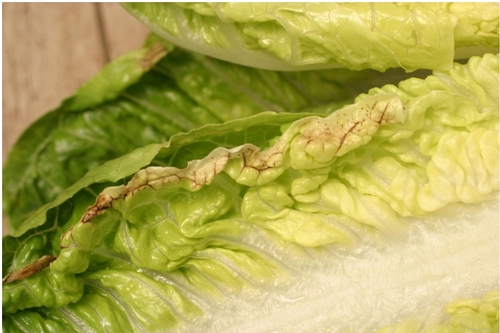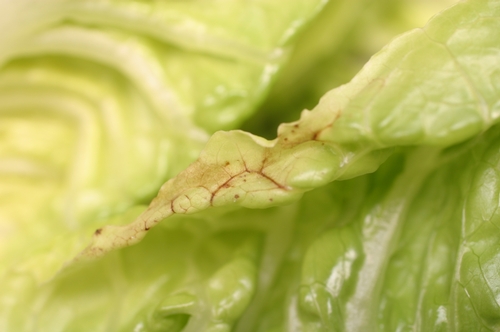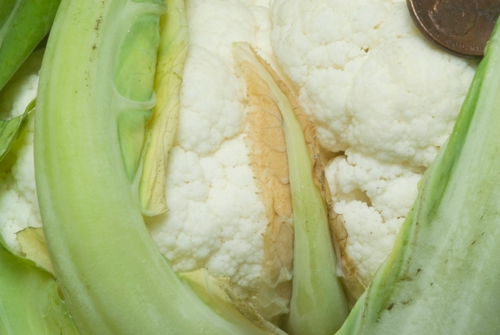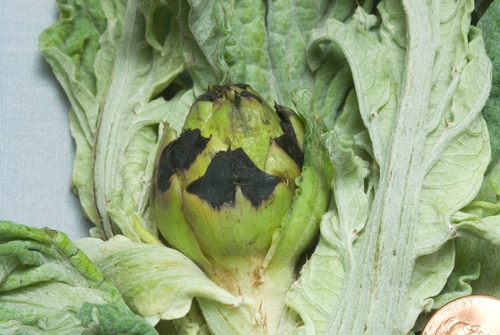- Author: Richard Smith, Tim Hartz and Ryan Hayes Vegetable Crops and Weed Science Farm Advisor, Extension Vegetable Specialist and USDA Lettuce Breeder, respectively.
Tipburn of lettuce is a calcium-related disorder which causes the development of necrotic areas on the inner leaves of romaine and other leaf lettuce and on enclosed leaves of head lettuce (Photo 1). The necrotic areas likely develop due to a localized calcium deficiency that causes tissue collapse of the affected cells. There are two key factors that affect the development of localized calcium deficiency: 1) uptake of adequate calcium from the soil, and 2) calcium transport through the plant.
In a study conducted from 2005-2006 Tim Hartz, Michael Cahn and I showed that soil calcium levels in the lettuce growing areas of the Central Coast were optimal for plant growth. Soil calcium levels as measured in saturate paste extract was found to be the best indication of available soil calcium to the plant. The reason for this is that soil calcium levels from saturated paste extracts can be easily converted to concentration of calcium in the soil water, as well as pounds of calcium per acre in the soil water. In the two-year survey of a number of soils in the Salinas and Central Valleys, calcium concentrations in the soil water were found to average about 680 ppm; this value exceeds the calcium levels that are used in hydroponic vegetable production systems (100 – 200 ppm). Only one sandy soil in the survey had calcium levels below 200 ppm.
In the study, the effect of supplementing soil calcium with calcium thiosulfate, calcium nitrate and calcium chloride through the drip system was evaluated. Calcium from these materials was applied at the rate of 10-15 pounds per acre. No impact on tipburn symptoms was observed in these trials. To understand why this occurred, it is important to compare the amount of calcium that was applied to what was already in the soil. Calcium levels in the soil water can be converted to pounds of available calcium on a per acre basis; the amount of available calcium in the soil water in these evaluations was approximately 200 pounds/A, so the fertigated calcium supplied only a small fraction of what already existed in the soil.
Another factor in calcium nutrition of lettuce is the effectiveness of calcium transport through the plant. Calcium moves in the xylem by transpirational flow and is delivered to all parts of the plant this way. Factors that reduce transpiration also reduce calcium availability to leaf tissue and may lead to tipburn symptoms. Leaves enclosed in head lettuce and inner leaves of romaine are susceptible to tipburn because they are not transpiring as readily as leaves in the open which can transpire freely. In addition, root growth of lettuce decreases approximately two weeks prior to maturity which can further limit the supply to calcium to the transpirational stream. Various aspects of the growth pattern and physiology of lettuce varieties affect their susceptibility to tipburn (Tables 1-3). In a study conducted in 2005 and 2006, Sylvie Jenni and Ryan Hayes, showed that, in general, head lettuce types are less sensitive to tipburn than romaine types. This is primarily due to greater breeding efforts on tipburn resistance dedicated to date for head lettuce types.
An additional factor that influences the development of tipburn on lettuce is the weather. Foggy weather that reduces transpiration in the last 6-10 days before harvest is conducive to the development of tipburn in susceptible varieties.
One practice that may have a place in reducing tipburn is the use of foliar applications of calcium prior to and/or during the critical period of lettuce development. I currently have four trials out evaluating this technique. At the recommended application rates of the materials being tested, weekly applications of 0.15 to 0.20 lbs of calcium are applied. The trials are currently underway, but the question will be, can we get enough calcium into the plant at the right time? In addition, can the spray reach the tissue that may develop the symptoms, given that calcium does not readily move in the phloem of the plant?
Conclusions: Lettuce production soils of the Central Coast generally have high levels of readily available calcium. Most coastal soils have well over 200 ppm of calcium in the soil water which is adequate for optimal plant growth. The greater issue for the development of tipburn in lettuce is the variety. In addition, persistent foggy conditions that reduce transpirational flow of calcium to all parts of the leaves in the last 6-10 days prior to harvest will trigger this disorder in sensitive varieties.

Photo 1. Tipburn symptoms along the edge of an inner leaf or romaine lettuce.
Table 1. Head Lettuce: percent of plants with tipburn tested in Salinas, California and Yuma, Arizona (adapted from Jenni and Hayes, 2010).
|
Variety |
California |
Arizona |
|||||
|
Salinas |
Yuma |
||||||
|
2005 |
2006 |
2005 |
2006 |
Mean |
|||
|
Calicel |
99.0 |
78.0 |
99.0 |
100.0 |
88.7 |
||
|
Calmar |
16.7 |
40.0 |
89.3 |
60.0 |
51.5 |
||
|
Cochise 47 |
43.3 |
13.3 |
79.3 |
66.7 |
50.7 |
||
|
Desert Spring |
40.0 |
76.7 |
89.7 |
80.0 |
71.6 |
||
|
Diamond |
1.0 |
36.7 |
86.0 |
13.3 |
34.3 |
||
|
Gabilan |
53.3 |
20.0 |
46.7 |
0.0 |
30.0 |
||
|
GLMesa659 |
37.0 |
40.0 |
99.0 |
33.3 |
52.3 |
||
|
Head Master |
10.3 |
39.6 |
76.3 |
33.3 |
39.9 |
||
|
Navajo |
16.7 |
66.7 |
73.0 |
20.0 |
44.1 |
||
|
Pacific |
1.0 |
8.1 |
49.7 |
40.0 |
24.7 |
||
|
Salinas |
14.0 |
46.7 |
76.3 |
13.3 |
37.6 |
||
|
Silverado |
7.0 |
26.7 |
66.3 |
0.0 |
25.0 |
||
|
Sniper |
26.7 |
26.7 |
76.3 |
26.7 |
39.1 |
||
|
Sundance |
30.3 |
80.0 |
69.7 |
20.0 |
50.0 |
||
|
Tiber |
1.0 |
53.3 |
69.7 |
13.3 |
34.3 |
||
|
Van 75 |
40.3 |
60.0 |
36.7 |
60.0 |
49.3 |
||
|
Vanmax |
43.3 |
90.0 |
79.3 |
26.7 |
59.8 |
||
|
Mean |
28.3 |
47.2 |
74.3 |
35.7 |
46.1 |
||
Table 2. Romaine: percent of plants with tipburn tested in Salinas, California and Yuma, Arizona (adapted from Jenni and Hayes, 2010).
|
Variety |
California |
Arizona |
|||||
|
Salinas |
Yuma |
||||||
|
2005 |
2006 |
2005 |
2006 |
Mean |
|||
|
Avalanche |
88.9 |
86.7 |
99.0 |
46.7 |
77.7 |
||
|
Beretta |
53.3 |
80.0 |
79.7 |
93.3 |
76.6 |
||
|
Brave Heart |
70.0 |
86.7 |
76.3 |
33.3 |
66.6 |
||
|
Caesar |
49.7 |
80.5 |
73.0 |
9.1 |
57.2 |
||
|
Clemente |
37.0 |
50.0 |
59.7 |
33.3 |
45.0 |
||
|
Conquistador |
93.0 |
78.3 |
82.7 |
33.3 |
71.8 |
||
|
Darkland |
53.3 |
80.0 |
86.3 |
66.7 |
71.6 |
||
|
Fresh Heart |
99.0 |
46.7 |
76.3 |
66.7 |
72.2 |
||
|
Gladiator |
36.7 |
96.7 |
99.0 |
33.3 |
66.4 |
||
|
Gorilla |
53.3 |
90.0 |
86.3 |
40.0 |
67.4 |
||
|
Green Towers |
40.0 |
60.0 |
89.3 |
53.3 |
60.7 |
||
|
Heart's Delight |
56.3 |
50.0 |
92.7 |
13.3 |
53.1 |
||
|
King Henry |
63.3 |
80.0 |
33.3 |
26.7 |
50.8 |
||
|
Lobjoits |
73.0 |
86.7 |
92.7 |
20.0 |
68.1 |
||
|
PIC 454 |
40.0 |
84.7 |
86.3 |
26.7 |
59.4 |
||
|
Paris Island Cos |
66.3 |
70.2 |
73.2 |
73.3 |
71.4 |
||
|
Ruebens Red |
93.0 |
82.9 |
99.0 |
73.3 |
86.6 |
||
|
Siskyou |
16.7 |
66.7 |
66.3 |
0.0 |
37.4 |
||
|
Sunbelt |
10.3 |
90.0 |
96.0 |
33.3 |
57.4 |
||
|
Triton |
66.3 |
81.1 |
76.3 |
33.3 |
64.3 |
||
|
Valmaine |
76.7 |
70.0 |
80.0 |
53.3 |
70.0 |
||
|
Mean |
58.9 |
76.1 |
81.1 |
41.1 |
64.4 |
||
Table 3. Leaf Lettuce: percent of plants with tipburn tested in Salinas, California and Yuma, Arizona (adapted from Jenni and Hayes, 2010).
|
Variety |
California |
Arizona |
|||||
|
Salinas |
Yuma |
||||||
|
2005 |
2006 |
2005 |
2006 |
Mean |
|||
|
Green Leaf |
|||||||
|
Big Star |
1.0 |
13.3 |
82.7 |
40.0 |
34.3 |
||
|
Envy |
73.0 |
33.3 |
76.7 |
26.7 |
52.4 |
||
|
Genecorps Green |
56.7 |
50.0 |
92.7 |
93.3 |
73.2 |
||
|
Grand Rapids |
99.0 |
60.0 |
96.0 |
73.3 |
82.1 |
||
|
Green Vision |
36.7 |
66.7 |
89.3 |
80.0 |
68.2 |
||
|
Ocean Green |
43.3 |
40.0 |
79.7 |
53.3 |
54.1 |
||
|
Shining Star |
13.7 |
33.3 |
86.3 |
53.3 |
46.7 |
||
|
Tehama |
51.1 |
53.3 |
99.0 |
33.3 |
59.2 |
||
|
Two Star |
60.0 |
36.7 |
96.0 |
66.7 |
64.8 |
||
|
Xena |
60.0 |
75.0 |
63.3 |
6.7 |
58.0 |
||
|
Mean |
49.5 |
46.2 |
86.2 |
52.7 |
59.3 |
||
|
Red Leaf |
|||||||
|
Aragon Red |
63.3 |
100.0 |
99.0 |
93.3 |
88.9 |
||
|
Deep Red |
69.7 |
23.3 |
99.0 |
93.3 |
71.3 |
||
|
New Red |
59.7 |
36.7 |
79.7 |
86.7 |
65.7 |
||
|
Red Fox |
1.0 |
93.3 |
69.7 |
13.3 |
44.3 |
||
|
Red Line |
63.0 |
93.3 |
89.7 |
86.7 |
83.2 |
||
|
Red Tide |
20.3 |
||||||
- Author: Steven T. Koike
- Author: Richard Smith
In the months of July and August of 2010, a number of vegetable crops in California’s central coast were affected by calcium deficiency disorders. Usually referred to as “tipburn” (except in the case of celery, for which the disorder is called “blackheart”), these problems are often triggered by environmental factors and hence can affect a large number of acres and plantings during windows of time when tipburn is occurring in Salinas and other coastal valleys.
Tipburn symptoms on lettuce, endive, radicchio, and spinach are distictive. Symptoms occur on the margins of developing leaf tips and initially consist of light to dark brown lesions and necrosis. In romaine, tipburn is often first seen on the small veins along the margin of young leaves. In severe cases tipburn can progress and result in extensive damage to these leaf margins. Symptomatic leaves are usually found within the inner whorls of open head vegetables and underneath the enclosing wrapper leaves of closed head vegetable types. For spinach, tipburn always affects the inner, newly developing leaves which may develop a hooded appearance as the leaf continue to expand around the dead tissue. For blackheart of celery, symptoms form on the margins of developing leaf tips deep within the central growing point. Such symptoms consist of light to dark brown speckling, lesions, and necrosis. As the celery grows, the damaged tissues turn black and the affected foliage grows up and out of the inner plant whorl.
For tipburn of artichoke, the margins of immature leaves turn black as in celery. In addition, the immature artichoke flower buds develop black lesions along the upper tips and edges of flower bracts. Cauliflower also develops tipburn, with the inner wrapper leaves enclosing the cauliflower head turning tan to light brown.
Tipburn is a localized calcium deficiency. It often develops along the margins of leaves in the final weeks before harvest when the plant growth rate is at its highest. It is often unrelated to soil calcium levels. Because calcium is not very mobile within the plant, expanding tissues on young leaves and growing points may run short of this essential element and begin to develop deficiency symptoms. Conditions that favor rapid plant growth (warm temperatures and high fertilization rates) or low transpiration rates (foggy conditions) may create conditions that trigger this disorder.
Managing this disorder is difficult. Varieties vary in susceptibility, but tipburn resistance is only available in head lettuce. Maintaining even soil moisture levels and preventing the root zone from drying out helps increase calcium uptake and may reduce the risk or severity of tipburn. For field grown vegetables, soil and foliar calcium supplements have not provided consistent control.
For further information on tipburn see Monterey County Crop Notes - July/August 2007
Initial symptoms of tipburn on romaine occur on veins at the edge of the leaf.

Tipburn of butter lettuce.

Tipburn of cauliflower.

Blackheart of celery.

Tipburn of artichoke.
- Author: Steven T. Koike
- Author: Jian Long Bi
The spring growing conditions have been responsible for several problems that affected head lettuce in coastal California. Rain and cold temperatures have allowed significant development of bacterial leaf spot (Xanthomonas campestris pv. vitians) and a physiological disorder possibly related to tipburn. In addition, recent samples, received by UC Cooperative Extension, have been infested by an insect. Field personnel and pest control advisors have also been detecting this problem.
Underneath the wrapper leaves, inner layers are being fed upon by the larval stage (maggot) of a fly insect. Damage consists of holes and breaks in the leaves where the maggot has been feeding (photos 1, 2, 3).
|
Photo 1 |

|
Photo 2 |

|
Photo 3 |

Edges of the damaged areas turn tan to brown. Such feeding damage can occur anywhere along the leaf and midrib tissue. Careful examination of the inner leaves will likely reveal the presence of the maggot (photo 4) and/or the pupa (photo 5). Maggots are small (approximately 7 mm (1/10th inch) long) and pale in color.
|
Photo 4 |

|
Photo 5 |

The insect damage, which consists of actual holes in the tissue, is distinct from the physiological problem that typically does not result in breaks in the leaf and which is usually restricted to the leaf margins. The bacterial leaf spot disease affects mostly outer leaves and results in characteristically black lesions.
Identification of the fly is pending and Entomology Farm Advisor Jianlong Bi will be investigating this further.
- Author: Richard Smith
- Author: Steven T. Koike
The rainy and cold spring weather in 2010 is apparently having an effect on head lettuce quality in Salinas Valley fields. Symptoms appear as very small, brown flecks and spots along the margins of young leaves (photo 1). Affected leaves are usually found deep within the head. It appears that these defects are occurring in multiple iceberg cultivars in various parts of the valley. Clearly this is a physiological disorder and superficially looks similar to russet spot; however, most of the flecks do not occur on the leaf midribs (photo 2) as would be typical for russet spot. Russet spot is caused by ethylene production and can occur in mature to over mature lettuce, especially following anaerobic conditions in the field. However, in this instance, the location of the flecking along the margin of the leaf more closely indicates tipburn.
The extensive nature of the problem (from Salinas to San Ardo) and the occurrence across varieties indicates that a large-scale factor like weather could be the cause. The heavy rain on April 5 followed by cloudy, cool weather may account for the currently wide distribution of the problem. We are conducting further investigations to more closely determine the cause of this problem.
These defects are not caused by any plant pathogen. Extensive testing has shown that bacterial leaf spot, anthracnose, or other lettuce disease is not associated with these brown flecks. Bacterial leaf spot (caused by Xanthomonas campestris pv. vitians), however, is common this year and should not be confused with this physiological disorder. Bacterial leaf spot occurs on the outer leaves and results in large, black, angular lesions (photo 3).
|
Photo 1: Lettuce defects in 2010 |

|
Photo 2: Typical russet spotting of lettuce |

|
Photo 3: Bacterial leaf spot of lettuce |



